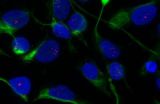(Press-News.org) At its most fundamental level, diabetes is a disease characterized by stress -- microscopic stress that causes inflammation and the loss of insulin production in the pancreas, and system-wide stress due to the loss of that blood-sugar-regulating hormone.
Now, researchers led by scientists at the University of California, San Francisco (UCSF) have uncovered a new key player in amplifying this stress in the earliest stages of diabetes: a molecule called thioredoxin-interacting protein (TXNIP). The molecule, they've discovered, is central to the inflammatory process that leads to the death of the cells in the human pancreas that produce insulin.
"This molecule does something remarkable -- it takes stress and makes it worse," said the senior author of the study, UCSF's Feroz Papa, MD, PhD, an associate professor of medicine at UCSF and a member of the UCSF Diabetes Center and the California Institute for Quantitative Biosciences (QB3).
The study is published this week in the journal Cell Metabolism, with a parallel study by researchers at Washington University in St. Louis. Both studies were funded by the Juvenile Diabetes Research Foundation (JDRF).
The work provides a roadmap for finding new drugs that could target and shut down the action of TXNIP, thus preventing or stalling the inflammatory processes it amplifies. Researchers in the field believe that this strategy could benefit people in the early days of the disease, when diabetes is first developing or is soon to develop -- a time referred to as the "honeymoon" period.
Clinical studies have already shown that dietary changes and other approaches can extend the honeymoon period in some people and prevent diabetes in others. The overarching goal of Papa's research, he said, is to find a way to extend this honeymoon period indefinitely.
Diabetes and the Loss of Beta Cells
Diabetes is a major health concern in the United States, affecting an estimated 8.3 percent of the U.S. population -- some 25.8 million Americans -- and costing U.S. taxpayers more than $200 billion annually. In California alone, an estimated 4 million people (one out of every seven adults) has type 2 diabetes, and millions more are at risk of developing it. These numbers are poised to explode in the next half century if more is not done to prevent the disease.
At the heart of diabetes is the specialized hormone-producing beta cells, which dot the human pancreas and produce the insulin that helps regulate a person's blood sugar.
These beta cells are like tiny biological factories that churn out insulin. A single beta cell might make a million molecules of insulin a minute. That means the billion or so beta cells in the average healthy pancreas will make more copies of insulin every year than there are grains of sand on every beach and in every desert in the world.
They are part of a delicate balance, however, and if the beta cells are lost, the pancreas may not be able to produce enough insulin and the body may not be able maintain proper blood sugar levels. That's exactly what happens in diabetes.
Stress to the Cells
Papa and his colleagues have found in recent years that underlying beta cell destruction and diabetes is stress within a part of the cell known as the endoplasmic reticulum (ER).
All cells have these structures, and the enveloped folds of the ER are easily spotted under a microscope. They play a crucial role in all human cells by helping to process and fold proteins the cells produce. But for beta cells, this structure is critical to their specialized function of secreting insulin.
If one thinks of a beta cell as a little factory, the ER would be like the shipping warehouse -- the packaging place where the end products are nicely wrapped, tagged with address labels, and sent to their final destination.
A healthy ER is like a well-run warehouse. Items are processed, packaged and shipped efficiently. A stressed ER, however, resembles a warehouse in shambles, with unboxed cargo accumulating everywhere. The longer this continues, the worse it becomes, and the body's solution to the problem is somewhat drastic: it essentially burns the factory down and closes the warehouse.
In scientific terms, the cell initiates what is known as the "unfolded protein response" in the ER, which activates inflammation through a protein known as interleukin-1 (IL-1). This process ultimately leads to apoptosis, the self-implosion of the beta cell.
For a whole organism, this is not as drastic as it sounds—with a billion or more beta cells in the pancreas, most people can afford to lose a few. The problem is that for far too many people, there are far too many warehouses burning down.
"There's not a lot of reserve in the human pancreas -- if these cells start dying, the remaining cells have to work harder," Papa said. Past some tipping point, the balance is lost and diabetes develops.
The Discovery of TXNIP's Role
Recognizing the importance of the inflammatory process in the development of diabetes, several pharmaceutical companies already have clinical trials underway to test potential new drugs that target the IL-1 protein.
In the new work, the UCSF team highlighted the protein TXNIP as a potential new target, until now an underappreciated central player in this process. TXNIP is involved in initiation of this destructive process of ER stress, unfolded protein response, inflammation and cell death.
They found that, as this process begins, a protein called IRE1 induces TXNIP, which leads directly to IL-1 production and inflammation. Removing TXNIP from the equation protects cells from death. In fact, when mice without this protein are bred with mice prone to developing diabetes, the offspring are completely protected against the disease because their insulin-producing beta cells survive.
What this suggests, said Papa, is that inhibiting TXNIP in people may protect their beta cells, perhaps delaying the onset of diabetes -- an idea that that will now have to be developed, translated and tested in clinical trials.
INFORMATION:
The article "IRE1a Induces Thioredoxin-Interacting Protein to Activate the NLRP3 Inflammasome and Promote Programmed Cell Death under Irremediable ER Stress" by Alana G. Lerner, John-Paul Upton, P.V.K. Praveen, Rajarshi Ghosh, Yoshimi Nakagawa, Aeid Igbaria, Sarah Shen, Vinh Nguyen, Bradley J. Backes, Myriam Heiman, Nathaniel Heintz, Paul Greengard, Simon Hui, Qizhi Tang, Ala Trusina, Scott A. Oakes and Feroz R. Papa appears in the
See: http://dx.doi.org/10.1016/j.cmet.2012.07.007
The work was supported by the Juvenile Diabetes Research Foundation (JDRF) and Burroughs Wellcome Fund and from the National Institutes of Health (NIH) through the NIH Director's Office (a New Innovator Award in 2007) and grants from the National Institutes of Diabetes and Digestive and Kidney Diseases (NIDDK).
UCSF is a leading university dedicated to promoting health worldwide through advanced biomedical research, graduate-level education in the life sciences and health professions, and excellence in patient care.
Follow UCSF
UCSF.edu | Facebook.com/ucsf | Twitter.com/ucsf | YouTube.com/ucsf
A molecule central to diabetes is uncovered
UCSF study suggests stress-amplifying 'TXNIP' protein may be powerful new drug target
2012-08-08
ELSE PRESS RELEASES FROM THIS DATE:
Study sheds light on underlying causes of impaired brain function in muscular dystrophy
2012-08-08
The molecular missteps that disrupt brain function in the most common form of adult-onset muscular dystrophy have been revealed in a new study published by Cell Press. Myotonic dystrophy is marked by progressive muscle wasting and weakness, as well as excessive daytime sleepiness, memory problems, and mental retardation. A new mouse model reported in the August 9 issue of the journal Neuron reproduces key cognitive and behavioral symptoms of this disease and could be used to develop drug treatments, which are currently lacking.
"The new animal model reproduces important ...
The first public data release from BOSS, the Baryon Oscillation Spectroscopic Survey
2012-08-08
The Third Sloan Digital Sky Survey (SDSS-III) has issued Data Release 9 (DR9), the first public release of data from the Baryon Oscillation Spectroscopic Survey (BOSS). In this release BOSS, the largest of SDSS-III's four surveys, provides spectra for 535,995 newly observed galaxies, 102,100 quasars, and 116,474 stars, plus new information about objects in previous Sloan surveys (SDSS-I and II).
"This is just the first of three data releases from BOSS," says David Schlegel of the U.S. Department of Energy's Lawrence Berkeley National Laboratory (Berkeley Lab), an astrophysicist ...
EARTH: Shake, rattle and roll
2012-08-08
Alexandria, VA – A team of researchers may have discovered a way to hear earthquakes. Not the noises of rattling windows and crumbling buildings, but the real sounds an earthquake makes deep underground as rock grinds and fails catastrophically. Typical seismic waves have frequencies below the audible range for humans, but the August issue of EARTH shows you where to find the voice of one seismic monster: the March 11, 2011, magnitude-9.0 Tohoku earthquake in Japan.
Beyond the novelty of simply hearing an earthquake, the team found that the new technology could possibly ...
UK hotel industry alive with innovation
2012-08-08
Large hotel chains are quick to adopt and adapt innovations developed in other industries, while smaller hotels make almost continual incremental changes in response to customers' needs. The UK hotel industry is alive with innovation and new ways of improving service for customers, research funded by the Economic and Social Research Council (ESRC) has found.
The findings of a project led by Professor Gareth Shaw of Exeter University and Professor Allan Williams of Surrey University run counter to the traditional image of the hotel sector as slow to change. Official measures ...
Unusual weather events identified during the Black Saturday bushfires
2012-08-08
Research has revealed that the extremely hot, dry and windy conditions on Black Saturday combined with structures in the atmosphere called 'horizontal convective rolls' -similar to streamers of wind flowing through the air - which likely affected fire behaviour.
The study is the first of its kind to produce such detailed, high-resolution simulations of weather patterns on the day and provides insights for future fire management and warning systems.
The work was led by Dr Todd Lane and Ms Chermelle Engel from The University of Melbourne with Prof Michael Reeder (Monash ...
Benefit of PET and PET/CT in ovarian cancer is not proven
2012-08-08
Due to the lack of studies, there is currently no proof that patients with ovarian cancer can benefit from positron emission tomography (PET) alone or in combination with computed tomography (CT). As regards diagnostic accuracy, in certain cases, recurrences can be detected earlier and more accurately with PET or PET/CT than with conventional imaging techniques. This is the conclusion of the final report by the German Institute for Quality and Efficiency in Health Care (IQWiG) in Cologne that was published on 23 May 2012.
More reliable diagnosis is supposed to improve ...
Queen's University Belfast makes significant cancer breakthrough
2012-08-08
A major breakthrough by scientists at Queen's University Belfast could lead to more effective treatments for throat and cervical cancer.
The discovery could see the development of new therapies, which would target the non-cancerous cells surrounding a tumour, as well as treating the tumour itself.
Researchers at Queen's Centre for Cancer Research and Cell Biology have found that the non-cancerous tissue, or 'stroma', surrounding cancers of the throat and cervix, plays an important role in regulating the spread of cancer cells.
The discovery opens the door for the development ...
Scientists discover the truth behind Colbert's 'truthiness'
2012-08-08
Trusting research over their guts, scientists in New Zealand and Canada examined the phenomenon Stephen Colbert, comedian and news satirist, calls "truthiness"—the feeling that something is true. In four different experiments they discovered that people believe claims are true, regardless of whether they actually are true, when a decorative photograph appears alongside the claim. The work is published online in the Springer journal, Psychonomic Bulletin & Review.
"We wanted to examine how the kinds of photos people see every day—the ones that decorate newspaper or TV ...
Humanities mini-courses for doctors sharpen thinking and creativity
2012-08-08
Mini-courses designed to increase creative stimulation and variety in physicians' daily routines can sharpen critical thinking skills, improve job satisfaction and encourage innovative thinking, according to Penn State College of Medicine researchers who piloted a series of such courses.
"For decades, career development theory has identified a stage that occurs at midlife, characterized by a desire to escape the status quo and pursue new ventures," said Kimberly Myers, Ph.D., associate professor of humanities. "It is increasingly clear that these mid-career professionals ...
Berlin beats London and Washington in league table of world's best democratic space
2012-08-08
New research from the University of Warwick suggests that Berlin has the best democratic space in the world, topping a list that includes London, Washington and Tokyo.
The list appears in a new book, 'Democracy and Public Space: The Physical Sites of Democratic Performance' written by Dr John Parkinson, from the University of Warwick's Politics and International Studies department.
Dr Parkinson carefully selected 11 capital cities and assessed how well they provide space for all kinds of democratic action. He visited Berlin, Washington, Ottawa, Canberra, Wellington, ...
LAST 30 PRESS RELEASES:
Synergistic effects of single-crystal HfB2 nanorods: Simultaneous enhancement of mechanical properties and ablation resistance
Mysterious X-ray variability of the strongly magnetized neutron star NGC 7793 P13
The key to increasing patients’ advance care medical planning may be automatic patient outreach
Palaeontology: Ancient tooth suggests ocean predator could hunt in rivers
Polar bears may be adapting to survive warmer climates, says study
Canadian wildfire smoke worsened pediatric asthma in US Northeast: UVM study
New UBCO research challenges traditional teen suicide prevention models
Diversity language in US medical research agency grants declined 25% since 2024
Concern over growing use of AI chatbots to stave off loneliness
Biomedical authors often call a reference “recent” — even when it is decades old, analysis shows
The Lancet: New single dose oral treatment for gonorrhoea effectively combats drug-resistant infections, trial finds
Proton therapy shows survival benefit in Phase III trial for patients with head and neck cancers
Blood test reveals prognosis after cardiac arrest
UBCO study finds microdosing can temporarily improve mood, creativity
An ECOG-ACRIN imaging study solves a long-standing gap in metastatic breast cancer research and care: accurately measuring treatment response in patients with bone metastases
Cleveland Clinic presents final results of phase 1 clinical trial of preventive breast cancer vaccine study
Nationally renowned anesthesiology physician-scientist and clinical operations leader David Mintz, MD, PhD, named Chair of the Department of Anesthesiology at the UM School of Medicine
Clean water access improves child health in Mozambique, study shows
Study implicates enzyme in neurodegenerative conditions
Tufts professor named Fellow of the National Academy of Inventors
Tiny new device could enable giant future quantum computers
Tracing a path through photosynthesis to food security
First patient in Arizona treated with new immune-cell therapy at HonorHealth Research Institute
Studies investigate how AI can aid clinicians in analyzing medical images
Researchers pitch strategies to identify potential fraudulent participants in online qualitative research
Sweeping study shows similar genetic factors underlie multiple psychiatric disorders
How extreme weather events affect agricultural trade between US states
Smallholder farms maintain strong pollinator diversity – even when far from forests
Price of a bot army revealed across hundreds of online platforms worldwide – from TikTok to Amazon
Warblers borrow color-related genes from evolutionary neighbors, study finds
[Press-News.org] A molecule central to diabetes is uncoveredUCSF study suggests stress-amplifying 'TXNIP' protein may be powerful new drug target



